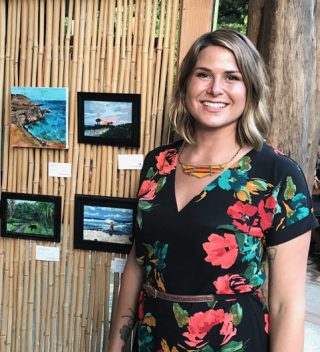As this transit from Hawai’i to Fiji was my first time being at sea, I was very curious to experience the ship’s movement. Before boarding I was nervous about big swells and any kind of inclement weather causing sea sickness, but within hours of being onboard I overheard that we were expecting smooth seas ahead – what a relief! From the moment the engine turned on and we slowly were piloted out of Honolulu Harbor, I was hyper aware of every movement: each roll and pitch of the ship as it tilted side to side, front to back – it was really new experience for me. As a way to document this movement, I wanted to conduct a daily exercise that would show the movement of the ship, something akin to a visual diary of our days at sea.
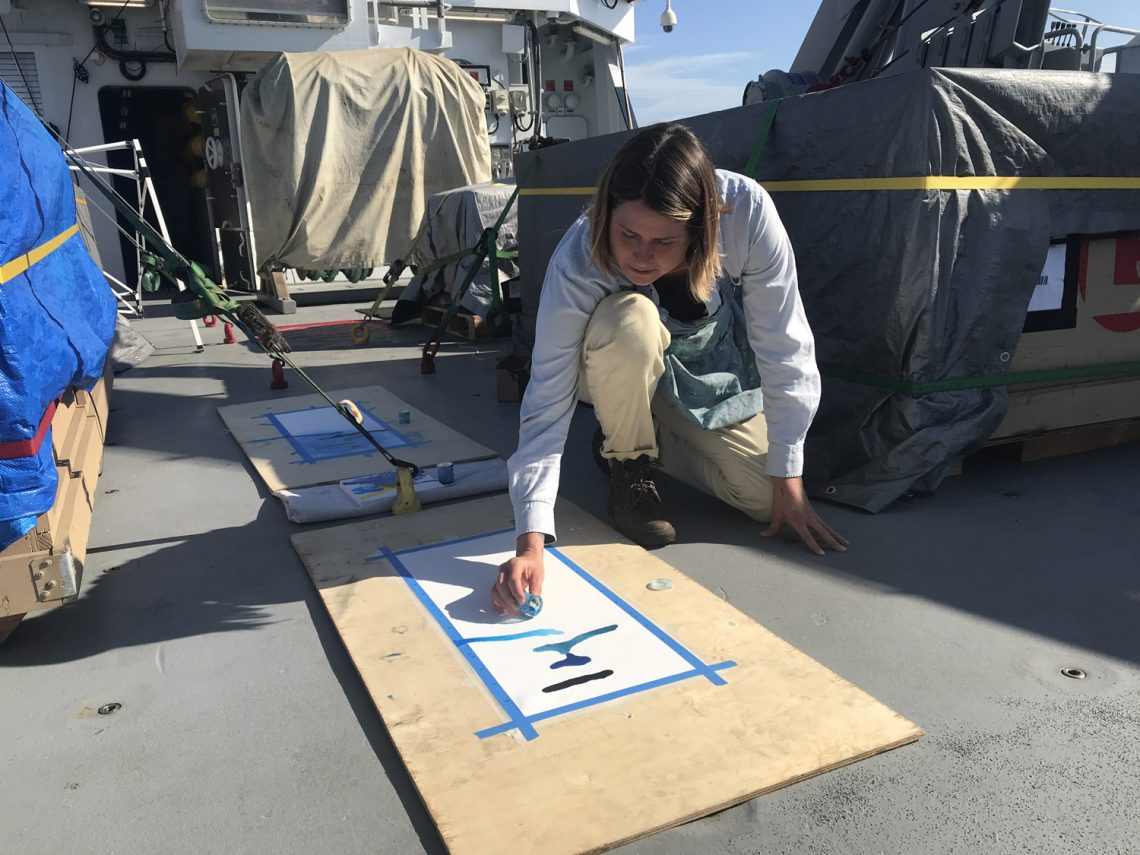
The first days were spent investigating the painting techniques and application, as well as understanding the requirements to conduct this two-week exercise. First, what became apparent was the need to understand how to paint on the moving vessel. My method is applying fluid acrylics to a sheet of canvas laid flat on the floor. The paint moved, the canvas moved, my body weight moved – there was a constant shift in the center of gravity that all the elements needed to adjust to. It was rather a fun way to be introduced to movement at sea through the lens of liquid paint.
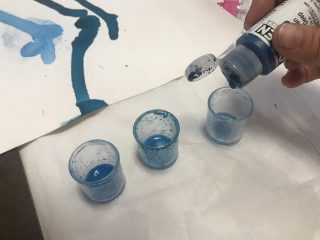 Almost immediately I noticed the paint had a dominant side-to-side movement from the roll of the ship. This would be something to consider for the composition, because when I first imagined the painting, I really thought the paint would move a bit more. So I tested a bit with the consistency of the paint. I applied test rounds and found every pour would be different, often the poured paint would be too watery and quickly flow over the edge. I wanted the paint to have a chance to puddle on the canvas. My painting style is expressionistic so it is rare that I perfectly measure my paint to medium ratios; it is a bit like cooking, a squeeze of a tube of paint with a pour of one or two mediums, stir, stir, add a little more water, more paint, stir. It is messy and very intuitive, so I realized I needed to be a bit more scientific for my pour-painting. I worked on a ratio and I found that 8 sprays of flow aid medium to 5 drops of paint was a consistent amount: enough flow, a good amount of pigment, yet not overly fluid where it would immediately run off the edge.
Almost immediately I noticed the paint had a dominant side-to-side movement from the roll of the ship. This would be something to consider for the composition, because when I first imagined the painting, I really thought the paint would move a bit more. So I tested a bit with the consistency of the paint. I applied test rounds and found every pour would be different, often the poured paint would be too watery and quickly flow over the edge. I wanted the paint to have a chance to puddle on the canvas. My painting style is expressionistic so it is rare that I perfectly measure my paint to medium ratios; it is a bit like cooking, a squeeze of a tube of paint with a pour of one or two mediums, stir, stir, add a little more water, more paint, stir. It is messy and very intuitive, so I realized I needed to be a bit more scientific for my pour-painting. I worked on a ratio and I found that 8 sprays of flow aid medium to 5 drops of paint was a consistent amount: enough flow, a good amount of pigment, yet not overly fluid where it would immediately run off the edge.
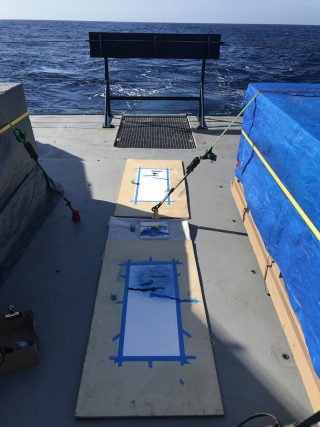 With my tools and techniques ready, I next found It was imperative to find a level floor that was not highly impacted by the trim of the ship. I decided to work centered on the very back deck of the ship, called the aft deck. I liked this spot because I was outside, and I could see the water behind us, and also had a clear view of how the boat was moving. I was intent on trying to time the pour when the boat was fairly lever right after it surged.
With my tools and techniques ready, I next found It was imperative to find a level floor that was not highly impacted by the trim of the ship. I decided to work centered on the very back deck of the ship, called the aft deck. I liked this spot because I was outside, and I could see the water behind us, and also had a clear view of how the boat was moving. I was intent on trying to time the pour when the boat was fairly lever right after it surged.
Weather elements were recorded just before each pour – I recorded the ships stats from the schimidtocean.com online database. I included columns of latitude/longitude, temperature, humidity, wind speed, ship speed, barometric readings, as well as my own observations of the weather and color. I would then inspect the sea and sky; I would select the color of paint for that day only based on personal observation. Each day around 9 am I would report to the aft deck, quieting down and focusing on the ship movement, taking a breath, pouring the paint, and leaving it be. I found it was a bit like a morning meditation.
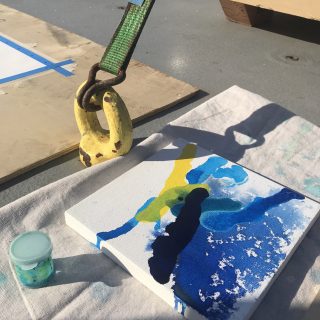 Sometime the hardest part of this painting seemed to be not interfering with the paint once it was poured. I wanted to manipulate it more, let it jump and be blown in a new direction – alas, that was the ship’s job. One day the captain radioed down to say there was rain ahead. I was elated, bring it on! It was a so fun to see the paint feather out as a new element had its affect on it. Early on in the painting exercise I realized I would needed to start another piece that was not so restricted by a linear grid. I began to include a smaller stretched canvas to the mix, using the same techniques as above, but allowing myself more artistic freedom when layering the paints and selecting the colors. The paint was generally poured in the center of the canvas, however I would turn the canvas and purposefully overlay the paints. What turned out so well was that it just happened to fit into the branding colors for Schmidt Ocean Institute, a complete “Happy Accident.”
Sometime the hardest part of this painting seemed to be not interfering with the paint once it was poured. I wanted to manipulate it more, let it jump and be blown in a new direction – alas, that was the ship’s job. One day the captain radioed down to say there was rain ahead. I was elated, bring it on! It was a so fun to see the paint feather out as a new element had its affect on it. Early on in the painting exercise I realized I would needed to start another piece that was not so restricted by a linear grid. I began to include a smaller stretched canvas to the mix, using the same techniques as above, but allowing myself more artistic freedom when layering the paints and selecting the colors. The paint was generally poured in the center of the canvas, however I would turn the canvas and purposefully overlay the paints. What turned out so well was that it just happened to fit into the branding colors for Schmidt Ocean Institute, a complete “Happy Accident.” 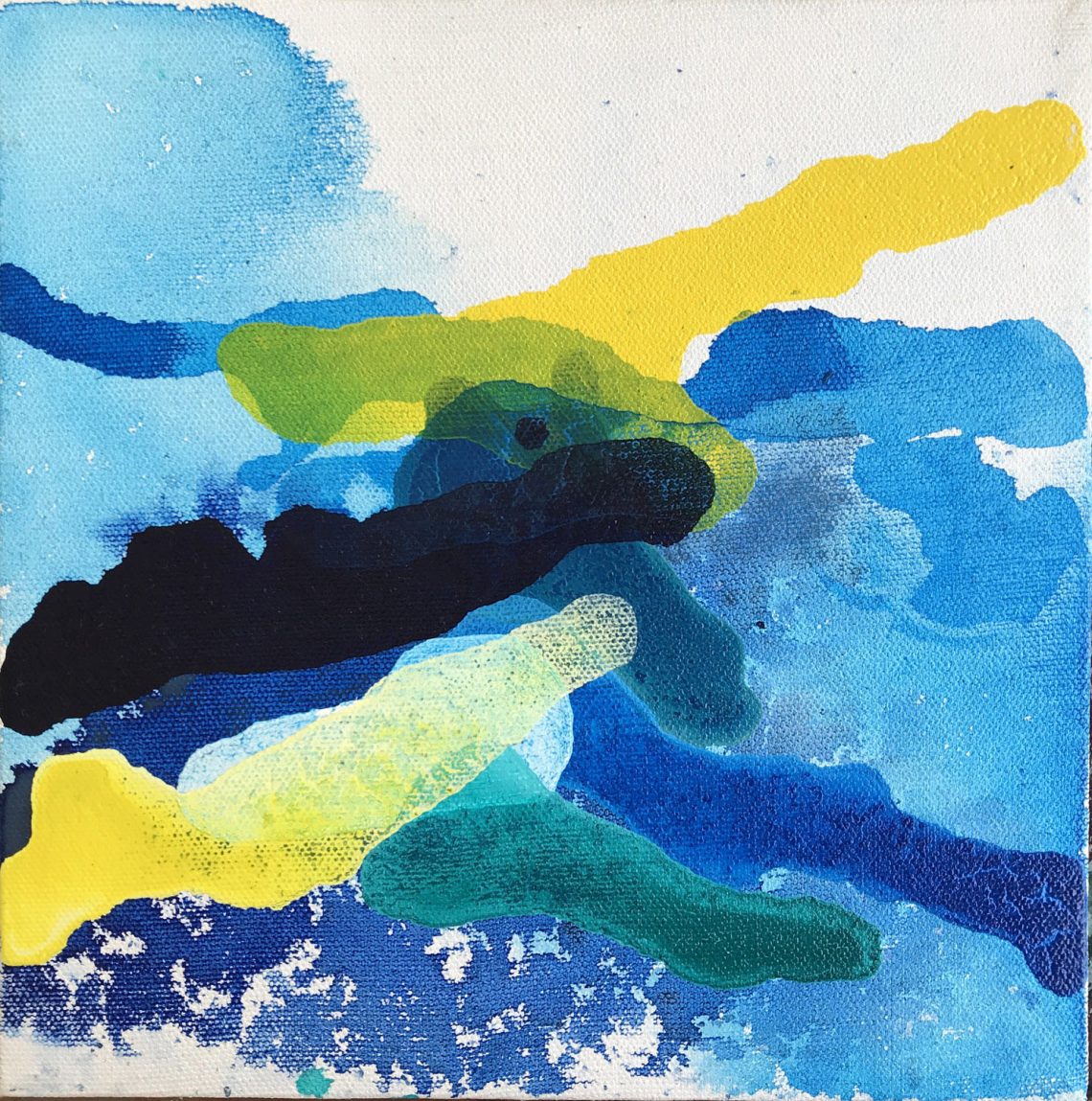
Everyday a new mark was poured onto the canvas, and as we moved into our second week at sea I was becoming very pleased with to see the layers build. The painting became a timeline for our days at sea. The most apparent are the calm days having very little flow past the central line. Then days with a little more roll show in the distance and turns the paint traveled. I called the Captain on the bridge before and after each work session to alert that I would be working on the Aft Deck, and most days we joked, “Another beautiful day in the Pacific. I’m walking the line of *almost* wanting worse weather for the sake of this project.” With the project in completion, I plan to stretch the final work and add in handwritten text the latitude and longitude coordinates as well as the atmospheric pressure to each pour. I hope to display these works on future Artist-At-Sea exhibitions with the Schmidt Ocean Institute.
